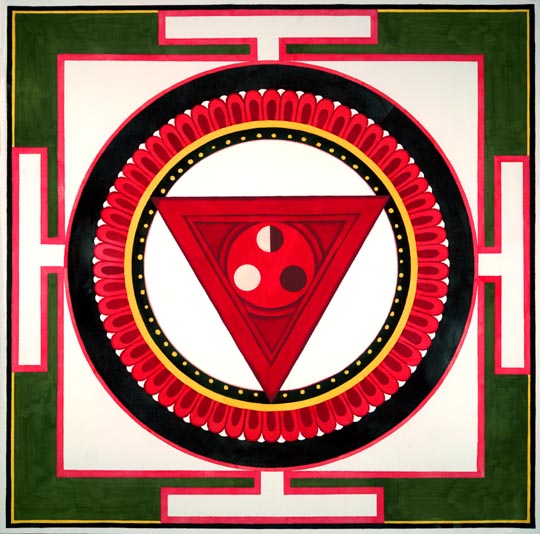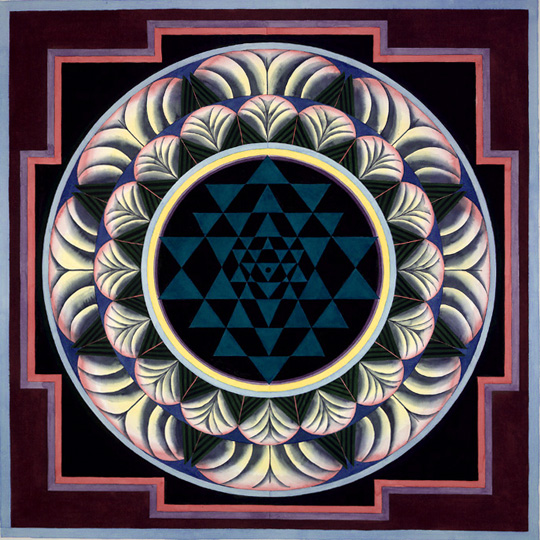Author Archives: Lisa.Greenleaf
Tripura-sundari Yantra
The third Mahavidya is Tripura-sundari (lovely in the 3 worlds), also known as Sodasi and Lalita among a string of other names. She is the zenith of the creative cycle when the entire universe, like a flower, is in full bloom. She is the chief deity of the Sri Vidya form of worship, and is contacted either in the central circuit of the Sri Yantra, or in her own yantra, the Nava-Yoni Chakra. Her anthropomorphic qualities are brilliancy, manifestation, sweetness, depth, fixity, energy, grace, and generosity.
Tripura Bhairavi
Tripura-Bhairavi (the fierce one in the 3 spheres) comes from before time, can take the form of the sun, and can dissolve the world as fire. She is the consort of Bhairava (a fierce form of Siva). In general, she is not thought of as a consort, but is independent of the gods and transcends them. While she is capable of exciting great passion, she is said to control passion as well. She is revealer and teacher, conferring the power of awakened consciousness that is cultivated in tantric spiritual practice. As all phenomena are in a dance of creation and dissolution, Bhairavi is present everywhere, implicitly offering revelation and awakened consciousness in this context. She is imaged with the crescent moon on her forehead.
Tara Yantra
In Hindu Tantrism, Tara is the second in this sacred circle and is known as the refining fire. She entered the circle of Mahavidyas from Buddhism where she is almost always known as a benevolent deity. In Hindu tantrism Tara is largely known for her fierce manifestations where she is seen as wild, unrestrained and dominant. As the refining fire, she is identified with the destructive but purifying fire that burns enslavement to the ego perspective and thus enables the transition from one form of existence to another.
Surya Yantra
 The power of Surya, the sun god, is conceived of as dispelling darkness both spiritual and earthly: curing disease, heating and illuminating the world. Surya is father of Manu (progenitor of the human race), Yama (lord of death), the Asvins (twin celestial horsemen), Karna (great warrior of the Mahabharata), and Sugriva (king of the monkeys).
The power of Surya, the sun god, is conceived of as dispelling darkness both spiritual and earthly: curing disease, heating and illuminating the world. Surya is father of Manu (progenitor of the human race), Yama (lord of death), the Asvins (twin celestial horsemen), Karna (great warrior of the Mahabharata), and Sugriva (king of the monkeys).
The sacred geometry for this watercolor was derived from a copper plate c.1700 from Rajasthan.
Sri III
…..Contemplation of the Sri Yantra can involve gently yet steadfastly focusing on the bindu. This process can allow the bindu to act like the eye of the needle, allowing the viewer the awareness of the baggage to be dropped in order to pass through or into it. As one meditatively focuses and refocuses on the bindu in its primordial feminine triangle, one is aware peripherally of dynamically flickering cosmic play as the content of this yantra unfolds.
Sri II
….The rush of these impressions in our lives is portrayed in the Sri Yantra by the continual shifting and reorganizing of the geometry to the beholding eye. Composed of nine intersecting triangles, four upward pointing (masculine) and five downward pointing (feminine), each resulting triangle of this configuration has its presiding deity or, one might say, its uniquely patterned energy node. ….. Continued
Sri I

The Sri Yantra, most revered of all the yantras, manifests the fully created cosmos arising from the union of all opposing energy. This cosmos is our world of multiplicity supported by the essential unity of the primordial bindu at its center. At the very inception of creation, the union of vibrational opposites has spawned continual divine cosmic play (Leela) which we experience as the ever-changing flow of our impressions of and responses to the appearance of phenomena. ….. Continued
Siva/Sakti Yantra
 This yantra brings forth the living energy of the Siva/Sakti relationship. Siva is the great ascetic god (not unlike the Greek god Cronus. or Saturn) who wounds in order to heal more deeply. His consort, Sakti, manifests the kinetic power that is the foundation of all life. Siva manifests consciousness and is the paradigm of meditative quiet and unshakable stillness. And paradoxically, his acts are frequently disconcerting and unpredictable. Nevertheless, he is beautiful, ultimately beneficial, and healing and thus an object of intense devotion. In this work, Siva appears as the white bindu and Sakti as the red within the primal triangle symbolizing their essential unity. The essence of Tantrism is the record of the stream of dialogues between Siva and Sakti.
This yantra brings forth the living energy of the Siva/Sakti relationship. Siva is the great ascetic god (not unlike the Greek god Cronus. or Saturn) who wounds in order to heal more deeply. His consort, Sakti, manifests the kinetic power that is the foundation of all life. Siva manifests consciousness and is the paradigm of meditative quiet and unshakable stillness. And paradoxically, his acts are frequently disconcerting and unpredictable. Nevertheless, he is beautiful, ultimately beneficial, and healing and thus an object of intense devotion. In this work, Siva appears as the white bindu and Sakti as the red within the primal triangle symbolizing their essential unity. The essence of Tantrism is the record of the stream of dialogues between Siva and Sakti.
Matangi Yantra
|
“Little muddy ones, come to me. Encrusted ones, come to me And let me turn your soil into nourishment for your Soul.” |
Daughter of hunter-king, Matanga, and of Buddhist as well as Hindu origin, Matangi’s home is deep within the jungle. She is radiantly dark in color, dressed in red, has the disc of the moon on her forehead and is usually flanked by two parrots. She is of low caste, a Cangala. She is known as “Uccista-matangini”: the bestower of all boons on the unwashed, and asks, in turn, for polluted offerings…. a goddess for our age of pollution and waste. No vows or preparation of any kind are needed to ask for her blessing and the uninitiated are welcome. She offers psychic power and liberation to consciousness bound by social conformity and conventionality. She nourishes the sixty-four arts and plays the vina. One can ask her for poetic talent or any other gift associated with creation. Her name is pronounced Mah-tahng-GI (with a hard G).
This watercolor attempts to bring in the feel of the jungle (which is Her home) to the sacred geometry of the yantra of Matangi.





